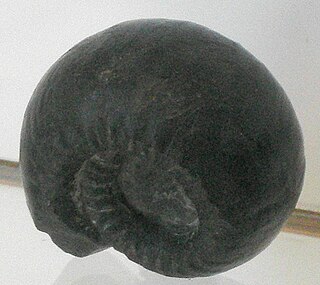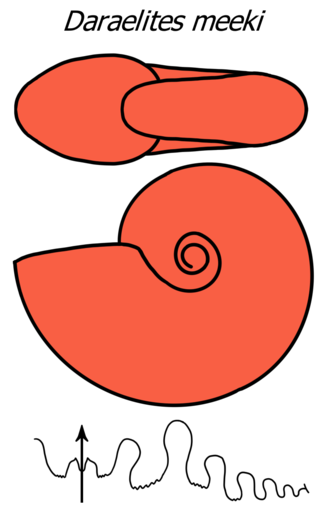Agathiceras is a subglobose goniatitid from the family Agathiceratidae, widespread and locally abundant in Lower Pennsylvanian to Middle Permian sediments, e.g. the Urals, Sicily, and Texas.

Goniatitina is one of two suborders included in the order Goniatitida; extinct Paleozoic ammonoid cephalopods only distantly related to the Nautiloidea.

Tornoceratina is one of two suborders included in the Goniatitida, characterized by generally involute, subdiscoidal shells and by sutures in which the ventral ones are undivided.
Dimeroceratidae is one of three families in the Dimeroceratoidea, a goniatid superfamily included in the Ammonoidea; extinct shelled cephalopods with adorally convex septa and usually narrow ventro-marginal siphuncles.
Prolobitidae is a family of middle and upper Devonian ammonoid cephalopods currently included in the goniatitid suborder Tornoceratina and superfamily Dimeroceratoidea, but previously included in the ancestral Anarcestida.
The Posttornoceratidae are Late Devonian goniatites (Ammonoidea) included in the superfamily Tornoceratoidea. The family, Posttornoceratidae, named by Bogoslovsky in 1962, is based on the genus Posttornoceras, named by Wedekind in 1910, originally included in the Tornoceratidae.
Dimorphoceratoidea is one of seventeen superfamilies included in the ammonoid suborder Goniatitina, a variety of shelled cephalopods that lived during the late Paleozoic.

Gastrioceratoidea is one of 17 superfamilies in the suborder Goniatitina, ammonoid cephalopods from the Late Paleozoic.
Adrianitidae is a family in the Adrianitaceae, a superfamily of ammonites in the cephalopod order, Goniatitida, known from the Middle Pennsylvanian to the Middle Permian.

Cyclolobidae: Goniatitid Ammonoidea belonging to the Cycloloboidea with thickly discoidal to subglobular shells with a small but open umbilicus and ammonitic sutures with numerous lobes that have subparallel sides.
Dimorphoceratidae is one of two families included in the Dimorphoceratoidea, a superfamily of ammonoid cephalopods belonging to the Goniatitida that lived during the Late Paleozoic. They are dimorphocerataceans in which the external lateral lobes and prongs of the ventral lobe are bifid. The shells are strongly involute, subdiscoidal to lenticular.
Agathiceratidae, as revised, makes up the goniatitid superfamily Agathiceratoidea. Agathiceratidae, which lived from the Upper Carboniferous (Pennsylvanian) to the Middle Permian, combine related genera with subdiscoidal to globular shells that have a small umbilicus and goniatitic sutures and are prominently longitudinally lirate. The explanation for the Agathiceratidae is that for the Agathiceratoidea.

Goniatitidae is one of three families included in the ammonoid cephalopod superfamily Goniatitoidea, known from the Lower Mississippian to the Upper Permian. They have sutures that form 8 lobes and characteristically lack sculpture. The ventral lobe, as for the superfamily, is bifurcated.

Goniatitinae is one of six subfamilies into which the Goniatitidae is subdivided according to Miller, Furnish, and Schindewolf, 1957. The diagnostic character is the narrow bifurcated ventral lobe of the suture, which lies along the outer rim. As with the inclusive Goniatitidae, sutures have eight lobes, shells are without prominent ornament, umbilici are small to moderate in size.

Prolecanitida is an order of extinct ammonoid cephalopods, the major Late Paleozoic group of ammonoids alongside the order Goniatitida. Prolecanitids had narrow shells, discoidal (disc-shaped) to thinly lenticular (lens-shaped). They retained a retrochoanitic siphuncle, a simple form with septal necks extending backwards. As is typical for ammonoids, the siphuncle sits along the ventral margin of the shell.

Prolecanitoidea is a taxonomic superfamily of ammonoids in the order Prolecanitida. Prolecanitoidea is one of two superfamilies in the order, along with the younger and more complex Medlicottioidea. The Prolecanitoidea were a low-diversity and morphologically conservative group. They lived from the Lower Carboniferous up to the Middle Permian. Their shells are generally smooth and discoidal, with a rounded lower edge, a moderate to large umbilicus, and goniatitic to ceratitic sutures. Suture complexity varies from 10 up to 22 total lobes ; new lobes are added from subdivision of saddles adjacent to the original main umbilical lobe.

The Daraelitidae form a family in the ammonoid order Prolecanitida from the Upper Mississippian - Middle Permian characterized by discoidal shells with no prominent sculpture, moderately large umbilicus, and goniatitic or ceratitic sutures with a trifid ventral lobe and few auxiliary lobes.

Agoniatitida, also known as the Anarcestida, is the ancestral order within the cephalopod subclass Ammonoidea originating from bactritoid nautiloids, that lived in what would become Africa, Asia, Australia, Europe, and North America during the Devonian from about the lower boundary of Zlichovian stage into Taghanic event during upper middle Givetian, existing for approximately 25 million years.

Clyclolobus is a smooth, essentially involute subdiscoidal goniatitid ammonoid that has sutures with a bifurcate ventral lobe, flared outwardly at the end, in which the halves may be secondarily trifurcated, ending in sharp, narrow projections. Lateral sutural elements follow an acuate line that swings first to the front, then sharply to the rear before becoming hidden by the next whorl. Saddles are narrow, cumulous in appearance with short, irregular, rounded sub-endings. Ventro-lateal lobes are trifurcate with pointed, thorn-like projections.
Cravevoceras is an Upper Paleozoic ammonite in the goniatite family Cravenoceratidae, probably derived from Pachylyroceras and contemporary with other cravenoceratid genera like Caenolyroceras, Tympanoceras and later Alaoceras and Lyrogoniatites. It is also a member of the Neoglyphioceratoidea.







